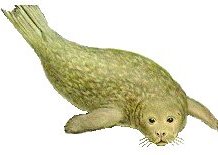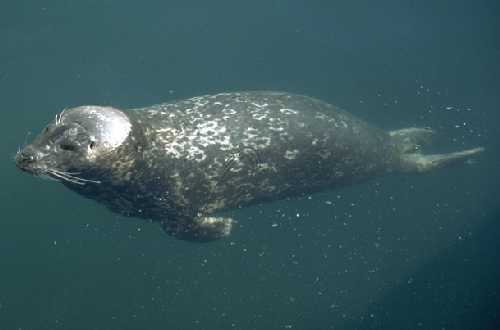Harbor Seal

Phoca vitulina
by Larry Sarner
Wild seals conjure up images of northern or even Arctic climates. But few people know that more than a hundred harbor seals call New Jersey home during the winter months, coming ashore into isolated estuaries and even upstream into a few rivers.
New Jersey is near the southern limits of the range for harbor seals on the East Coast. However, these seals are frequent visitors offshore in winter and even have been reported as far south as the mouth of the Chesapeake Bay in Virginia and off the coast of North Carolina. The winter seal-sighting season runs from December through March. Seals generally leave the New Jersey coast by the second week in April, probably responding to rising air and water temperatures and the increase in human activity.

The harbor seal, Phoca vitulina concolor, is found in both the North Atlantic and Pacific oceans and their adjoining seas. Here in the East, the population is about 10,000, concentrated mostly in the Bay of Maine, the Bay of Fundy in southern Canada and the Canadian Maritimes, where they come to land in summer to molt and have their pups. A single pup is born and nursed for up to six weeks, reaching up to 50 pounds and having a full set of teeth by the time it finally is weaned.
Harbor seals grow to an adult length of about six feet for males and five feet for females and weigh up to 250 pounds. They reach maturity in three to five years and have been known to live up to 35 years in captivity. The color of harbor seals varies from light gray to tan to reddish brown, and some are spotted or blotched with black. Each summer, they sport a new coat following the molt. Harbor seals have no external ears.
Their body shape, while looking bulky and awkward on land, is very efficient for life in the water. The shape is rounded out by a layer of blubber, which is effective in holding in body heat. They swim propelled by the side-to-side motion of their rear flippers, gliding gracefully through the water between power strokes. A great way to examine seal locomotion is to watch them through the glass walls of their enclosure at the Thomas H. Kean New Jersey State Aquarium in Camden.
Seals are avid swimmers and have been recorded down to 600 feet in depth with dives lasting up to a half hour.
In the more northern waters, seals often come ashore on rocky ledges as the tide falls and feed in open water during high tide. In New Jersey, isolated sand bars, exposed during low tides, may serve as resting areas. But at least one large group of seals in this state does the opposite, apparently because the sod banks of the salt marshes are hard to scale during low tide. This group feeds at low tide and comes out onto the marsh or salt hay at high tide.
In New Jersey waters, harbor seals feed mostly on herring and related fish, but they also are known to eat octopus, squid, shrimp, crabs and mollusks. These items are swallowed whole or ripped off in large chunks. Seals can eat up to 15 percent of their body weight each day.

Seals are protected species in New Jersey and are regulated by state non-game laws as well as the federal Marine Mammal Protection Act of 1972. Today, the species are on a comeback and can only can be taken by permit from United States waters. But they were nearly exterminated at the turn of the twentieth century after a bounty was offered to reduce the seal population in an effort to increase fish stocks.
Prior to the 1972 federal law, seals also were used for mink food, skins, leather products, biomedical research and public display. Today, they still fall victim to storms, abandonment by the mother, disease, parasites and predation by sharks and orcas.
The Marine Mammal Stranding Center, a refuge for injured or orphaned marine life in Brigantine, reports an increase in seal strandings along the New Jersey coast in the 1990s. More than a dozen seals, including harbor seals, harp seals and an occasional gray seal, wash up on shore every year. This compares to just a few seals found each year during the 1970s and 1980s. One theory as to why many seals are turning up on New Jersey's coast is that the world's fishing stock has been so depleted that many seal species are traveling farther and farther afield in search of food.
Most of those stranded on the beach are yearlings. All of them have parasites, and most suffer from respiratory problems. When the seals have regained their health at the center, they are tagged or numbered with a bleached marking and released. The data gained in these encounters could provide useful information on their habits and habitats in the long run.
Seals generally are shy when encountered in their resting areas. But when they are in open water, they may exhibit curiosity towards humans and come quite close to boats. In some cases, this curiosity has been hazardous as the seal becomes entangled in plastic lines, ropes and fishing gear.
Seals in the wild should not be approached; even the young can deliver a nasty bite. If you find a seal in distress, contact the Marine Mammal Stranding Center at (609) 266-6300.
Larry Sarner is a biologist specializing in marine, coastal and aquatic education programs with the New Jersey Division of Fish, Game arid Wildlife
This article first appeared in New Jersey Outdoors - Winter 1996


